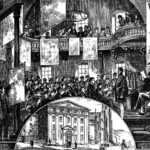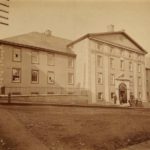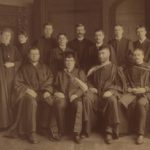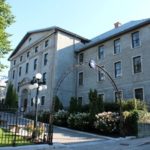Morrin College
Historical Information:
The Morrin College building, designed by Quebec City architect François Baillargé (1759-1830), was built between 1808 and 1812 to serve as the city’s common prison. Used as a penitentary from 1813 to 1867, it is Lower Canada’s oldest prison. It replaced the former Redoute Royale, built in 1712, which served as the city’s prison during the 18th century.
Construction was halted in 1811 to undergo a review of the building’s costs. It was completed after the approval of new funding the following year. Additional work was needed in 1817 due to defects in the original construction.
Baillargé, who came from a family of artists and architects, was one of Quebec’s most important 19th-century architects. Educated in Paris, his designs are often more traditional and standardized than those of his contemporaries, integrating classical designs and influences into his work. He is responsible for a number of Quebec’s most important early buildings, including Quebec City’s courthouse, constructed in 1799 (now demolished), as well as Trois-Rivières’ prison.
Following debates regarding reform of the penal system between 1826 and 1830, government authorities put architect Frederick Hacker (c. 1802-1846) in charge of modifying the prison. The changes conformed to new ideas surrounding imprisonment and rehabilitation of prisoners, and made the building more secure. During this period, the prison held several individuals who later became famous, including journalist and patriot Étienne Parent (1802-1874, as well as Philippe Aubert de Gaspé (1786-1871), who was imprisoned for debts.
The Union government constructed a new prison on the Plains of Abraham in the late 1850s to replace the outdated facility. In 1861, the building was sold to Morrin College, which had been looking to relocate its classes. Affiliated with McGill University, the institution was founded via a bequest by Dr. Joseph Morrin (1794-1861), two-time mayor of Quebec City. The college educated members of the Anglophone community until 1902. Morrin College did not take possession of the building until 1867, once the prison had been moved to the new location and architect Joseph-Ferdinand Peachy (1830-1903) modified the facility’s interior and exterior. The architect softened some of the building’s harsh features and demolished the four latrine towers from the rear facade. Morrin College opened its doors in 1868. The facility also housed the library and museum of the Literary and Historical Society of Quebec, founded in 1824 by governor general Lord Dalhousie (George Ramsay, 1770-1838). The LHSQ had as its goals to conserve, catalog and present documents from Canadian history. Until 1924, it published Transactions, which discussed the society’s scientific activities; as well as Historical Documents, which included reprints of original documents dealing with the origins of Canada. After the closing of Morrin College, the building welcomed several other associations from Quebec City’s anglophone community. Gradually, the LHSQ became a private community English-language library.
The building was designated as a National Historic Site of Canada in 1981. The Quebec City government acquired the building in 1989 and began a restoration of the its exterior. In 2004, it was leased to the LHSQ for 99 years. The interior was also restored at that point, and the building now houses the Morrin Centre, a keystone of Quebec City’s anglophone community.
Images




